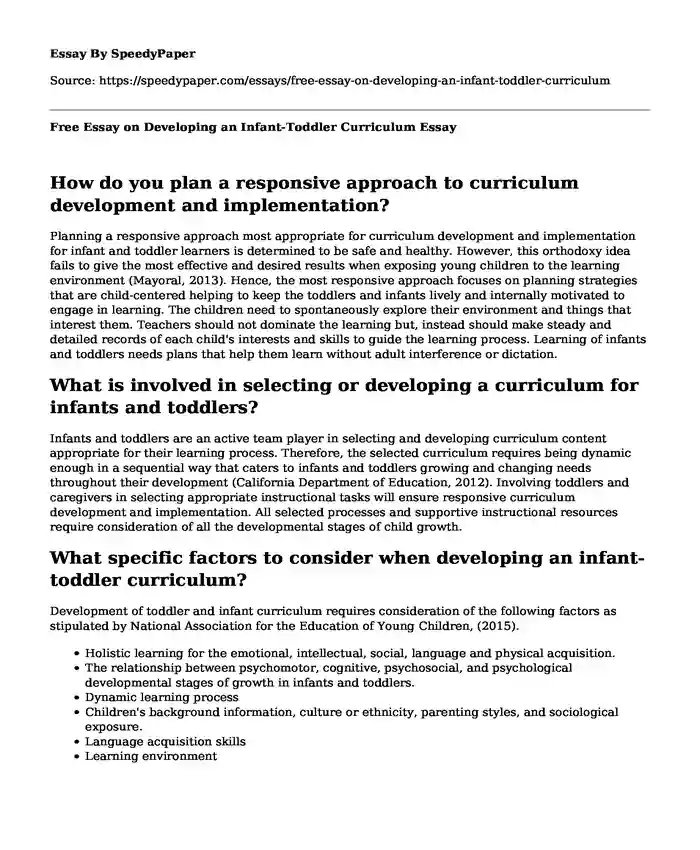
| Type of paper: | Course work |
| Categories: | Teaching Child development |
| Pages: | 2 |
| Wordcount: | 400 words |
How do you plan a responsive approach to curriculum development and implementation?
Planning a responsive approach most appropriate for curriculum development and implementation for infant and toddler learners is determined to be safe and healthy. However, this orthodoxy idea fails to give the most effective and desired results when exposing young children to the learning environment (Mayoral, 2013). Hence, the most responsive approach focuses on planning strategies that are child-centered helping to keep the toddlers and infants lively and internally motivated to engage in learning. The children need to spontaneously explore their environment and things that interest them. Teachers should not dominate the learning but, instead should make steady and detailed records of each child's interests and skills to guide the learning process. Learning of infants and toddlers needs plans that help them learn without adult interference or dictation.
What is involved in selecting or developing a curriculum for infants and toddlers?
Infants and toddlers are an active team player in selecting and developing curriculum content appropriate for their learning process. Therefore, the selected curriculum requires being dynamic enough in a sequential way that caters to infants and toddlers growing and changing needs throughout their development (California Department of Education, 2012). Involving toddlers and caregivers in selecting appropriate instructional tasks will ensure responsive curriculum development and implementation. All selected processes and supportive instructional resources require consideration of all the developmental stages of child growth.
What specific factors to consider when developing an infant-toddler curriculum?
Development of toddler and infant curriculum requires consideration of the following factors as stipulated by National Association for the Education of Young Children, (2015).
- Holistic learning for the emotional, intellectual, social, language and physical acquisition.
- The relationship between psychomotor, cognitive, psychosocial, and psychological developmental stages of growth in infants and toddlers.
- Dynamic learning process
- Children's background information, culture or ethnicity, parenting styles, and sociological exposure.
- Language acquisition skills
- Learning environment
References
California Department of Education, (2012). California infant/toddler curriculum framework. Sacramento: California Department of Education. Retrieved from http://www.cde.ca.gov/ sp/Cd/re/documents/itcurriculumframework.pdf
Mayoral, M. V. (2013). Supporting babies through QRIS: Inclusion of infant-toddler quality standards. Washington, DC: Zero to Three. Retrieved from https://www.zerotothree.org/resources/190-supporting-babies-through-qris-inclusion-of-infant-and-toddlerquality-standards.
National Association for the Education of Young Children, (April 2015). NAEYC early childhood program standards and accreditation criteria & guidance for assessment. Standard 2-Curriculum. Retrieved from http://www.naeyc.org/files/academy/file/ AllCriteriaDocument.pdf
Cite this page
Free Essay on Developing an Infant-Toddler Curriculum. (2022, Jun 15). Retrieved from http://land-repo.site.supplies/essays/free-essay-on-developing-an-infant-toddler-curriculum?pname=speedypaper.com
Request Removal
If you are the original author of this essay and no longer wish to have it published on the SpeedyPaper website, please click below to request its removal:
- Positive Impact of Rebellion, Free Essay in Political Science
- Sherlock Holmes Essay Sample
- Free Essay with Summary of Ethical Dilemma
- Article Review Essay: Labour Conflict Between Administrative Medical and Nursing Personnel in Hospital
- Culture of Syria Essay Example
- Effects of COVID-19 Crisis to Instruction in Colleges - Free Paper Sample
- Understanding Trauma in Classrooms: Importance of Trauma-Informed Teaching and Educator Self-Awareness
Popular categories




